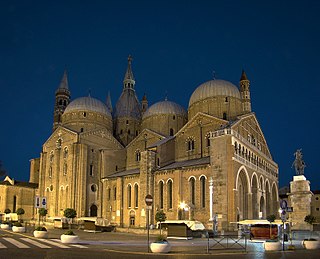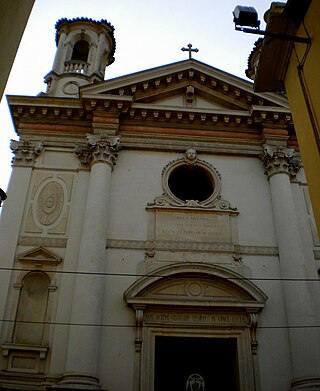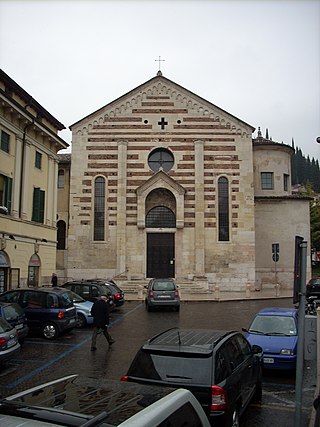
The Basilica del Carmine is a 16th-century Roman Catholic church located on piazza Francesco Petrarca in Padua, region of Veneto, Italy. It was made a minor basilica in 1960 by pope John XXIII [1]

The Basilica del Carmine is a 16th-century Roman Catholic church located on piazza Francesco Petrarca in Padua, region of Veneto, Italy. It was made a minor basilica in 1960 by pope John XXIII [1]
The church and an attached monastery were founded by an order of Carmelite monks, hence the name. The order became established in Padua by the late 13th-century, and we have the first documentation of a church at the site by 1212. The adjacent monastery was refurbished in 1295, and the church was rebuilt in 1335 under the design of Lorenzo da Bologna. It was consecrated as Santa Maria del Carmine in 1446. In 1491, an earthquake nearly razed the building, requiring reconstruction in 1494. The bare brick facade only gained partial marble facing in the 18th-century; formerly, the facade had an open loggia. The church structure suffered various damaging events over the centuries, including another earthquake collapsing the roof in 1696; a fire during festivities burned the cupola in 1800; and two aerial bombardments hit the church, in 1917 and 1944.
Among the former parishioners of this church was the beatified Elisabetta Vendramini, who founded the order of Elisabethan sisters.

The main portal was completed in 1412, with statues by Bonazza added in 1736–1737. The piazza in front of the church has a statue of Petrarch. On the left flank of the church is a commemorative plaque dedicated to parishioners who died during the second world war.

The counterfacade has a canvas depicting the Annunciation by Dario Varotari the Younger. The water fonts at the entrance were sculpted by Giovanni Bonazza.
The main altar has a detached fresco depicting the Virgin and child by Stefano Dall'Arzere. In 1576, while the bubonic plague afflicted the town, this venerated image was carried in procession through the city from its original location near the Palazzo del Capitanio to this church. The ebbing of the plague was attributed to the miraculous icon. Every February 2, during the Festa dei Lumini recalls this event. An 18th-century bas-relief depicts the Last Supper while the organ on the left depicts Stories of the Image of the Madonna of the Carmine by Battista Bissoni. The apse was richly decorated by Antonio Noale. The walls have large 17th-century canvases, depicting Saints of the Carmelite order and Stories of the Old Testament.
A recent restoration of the central nave, revealed Renaissance frescoes depicting prophets and sybils.
One of the chapels to the right of the entrance has the processional statue of the Madonna del Carmine, which is carried through the streets of the quarter, every July 16. Other works in the interior include:

The pavement is made from polychrome marble. The Polyptych of Lazarus by Francesco Squarcione, now in the Museo Civici of Padua, was originally in this church.


Adjacent to the basilica is a 15th-century cloister and a small prayer hall of the confraternity of the Carmine, known as the Scuola or Scuoletta del Carmine. It has splendid 16th century frescoes, including:

Padua is a city and commune in Veneto, northern Italy, and the capital of the eponymous province of Padua. The city lies on the banks of the river Bacchiglione, 40 kilometres west of Venice and 29 km southeast of Vicenza, and has a population of 214,000. It is also the economic and communications hub of the area. Padua is sometimes included, with Venice and Treviso, in the Padua-Treviso-Venice Metropolitan Area (PATREVE) which has a population of around 2,600,000.

Santa Maria dei Miracoli and Santa Maria di Montesanto are two churches in Rome.

Santa Maria del Carmine is a church in Naples, Italy. It is at one end of Piazza Mercato, the centre of civic life in Naples for many centuries until it was cut off from the rest of the city by urban renewal in 1900. The church was founded in the 13th century by Carmelite friars driven from the Holy Land in the Crusades, presumably arriving in the Bay of Naples aboard Amalfitan ships. Some sources, however, place the original refugees from Mount Carmel as early as the eighth century. The church is still in use and the 75–metre bell tower is visible from a distance even amidst taller modern buildings.

The Pontifical Basilica of Saint Anthony of Padua is a Catholic church and minor basilica in Padua, Veneto, Northern Italy, dedicated to St. Anthony of Padua.

Padua Cathedral, or Basilica Cathedral of Saint Mary of the Assumption, is a Catholic church and minor basilica located on the east end of Piazza Duomo, adjacent to the bishop's palace in Padua, Veneto, Italy.

Santa Maria dei Carmini, also called Santa Maria del Carmelo and commonly known simply as the Carmini, is a large Roman Catholic church in the sestiere, or neighbourhood, of Dorsoduro in Venice, northern Italy. It nestles against the former Scuola Grande di Santa Maria del Carmelo, also known as the Scuola dei Carmini. This charitable confraternity was officially founded in 1597, and arose from a lay women's charitable association, the Pinzocchere dei Carmini. The members of this lay group were associated as tertiaries to the neighbouring Carmelite monastery. They were responsible for stitching the scapulars for the Carmelites.

The Abbey of Santa Giustina is a 10th-century Benedictine abbey complex located in front of the Prato della Valle in central Padua, region of Veneto, Italy. Adjacent to the former monastery is the basilica church of Santa Giustina, initially built in the 6th century, but whose present form derives from a 17th-century reconstruction.

San Martino church, also called San Martino Maggiore is a Gothic-style, Roman Catholic church located at the corner of Via Marsala and Via Guglielmo Oberdan in Bologna, region of Emilia Romagna, Italy. The church was founded by the adjacent Carmelite monastery. On 10 August 1704 via the authority of the Vatican Chapter, the venerated image of the Virgin of Mount Carmel was crowned by Pope Clement XI. On 25 August 1941, Pope Pius XII elevated it to the status of basilica.

The church of Santa Maria delle Grazie in Brescia is located on at the west end of Via Elia Capriolo, where it intersects with the Via delle Grazie. Built in the 16th century and remodeled in the 17th century, it still retains much of its artwork by major regional artists, including one of its three canvases by Moretto. The other two are now held at the Pinacoteca Tosio Martinengo. The interior is richly decorated in Baroque fashion. Adjacent to the church is the Sanctuary of Santa Maria delle Grazie, a neo-gothic work.

Santa Croce is a Roman Catholic church located on Corso Vittorio Emanuele 178 in Padua, Veneto region, Italy.

Santo Stefano is a Paleo-Christian, Roman Catholic basilica church in central Verona, region of Veneto, Italy.

Santa Maria dei Servi, or simply known as the Chiesa dei Servi, or more fully as the Church of the Nativity of the Servants of the Blessed Virgin Mary, is a 14th-century, Roman Catholic church that faces the Via Roma in Padua, region of the Veneto, Italy. This is a parish church in the vicariate of the Cathedral Basilica of Santa Maria Assunta governed by the Servite Order. The church contains outstanding works of art including a wooden crucifix by Donatello.
The Oratory of San Bovo is a Roman Catholic prayer hall located on via Del Torresino #4 in Padua, region of Veneto, Italy.

Santa Maria in Vanzo is a Renaissance-style, Roman Catholic church in Padua, region of Veneto, Italy.

Santa Caterina d'Alessandria or Saint Catherine of Alexandria is a Roman Catholic church with a main facade on Piazza Bellini, and a lateral Western facade facing the elaborate Fontana Pretoria, in the historic quarter of Kalsa in the city of Palermo, region of Sicily, Italy. In front of the main facade, across the piazza Bellini, rise the older churches of San Cataldo and Santa Maria dell'Ammiraglio, while across Piazza Pretoria is the Theatine church of San Giuseppe and the entrance to the Quattro Canti. Refurbished over the centuries, the church retains elements and decorations from the Renaissance, Baroque, and late-Baroque (Rococo) eras. This church is distinct from the Oratorio di Santa Caterina found in the Olivella neighborhood.

The Madonna Addolorata al Torresino, also called the Santa Maria del Pianto or Santa Maria del Torresino is a Roman Catholic parish church located in the city of Padua, region of Veneto, Italy.

Santa Tecla is the Baroque-style, Roman Catholic duomo or main church in the town of Este, province of Padua, region of Veneto, Italy.
The Diocesan museum of Padua displays arts and artifacts belonging to the Roman Catholic Diocese of Padua; it is housed in the 15th-century former bishop's residence or Palazzo Vescovile. The building, adjacent to the Cathedral of Padua, faces the Piazza del Duomo, can in the historic center of Padua, region of Veneto, Italy.

The Scuola del Santo or Scoletta was the headquarters of the Archconfraternity of St Anthony of Padua. It overhangs the churchyard of Basilica of Saint Anthony of Padua, next door to the St. George's Oratory.

Sant'Andrea is a Roman Catholic church located on Via Sant'Andrea in Padua, region of Veneto, Italy. Founded by the 12th-century as a parish church, the present church was completed in the late 19th century.